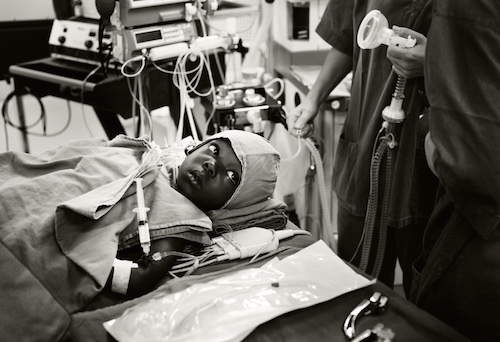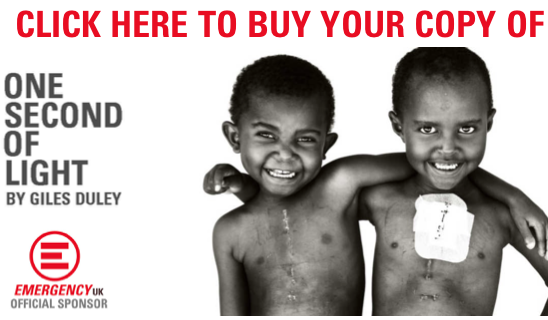Ajmal and his nephew were riding a motorcycle to visit his father in the hospital…

GILES DULEY: Documenting The Lives Saved By EMERGENCY
‘In my work as a humanitarian photographer I often work alongside non-governmental organisations (NGOs) documenting their work and the stories of those they help, people who are victims of circumstance. It was in this role that I first encountered EMERGENCY. From the beginning, I was struck by three things as paramount in EMERGENCY’s operations: efficiency; philosophy; and fulfilling need. I hope to explain these through my own experiences.’
– Giles Duley
To date, the Salam Centre has treated over 61,248 patients from 25 countries, many of whom travelled thousands of miles to receive treatment that would not otherwise have been available to them.
In 2010 I travelled to Sudan to document EMERGENCY’s pioneering work. What immediately struck me was the incredible hospital, whose design and standards of maintenance were superior to those of most of the hospitals I knew in the United Kingdom.
It is a beautiful building, designed by Raul Pantaleo, where function and form sit in unity. The corridors are wide, light, and spotless, the wards have only a few patients per room, and the staff are courteous to a fault. As one older lady said, they treated her “as if she was their mother”. The standard of the building and its hygiene mean that the hospital has some of the lowest infection rates in the world.
However, EMERGENCY’s attention to detail and quality of design are symbolic of more than just functionality and health, they embody the philosophy of EMERGENCY; that there should be no difference in how you treat people and by doing so you show that we are all the same.
EMERGENCY wants to show that a child in Africa will get exactly the same level of care and attention as a child in Europe and not just be ‘saved’.
Indeed, EMERGENCY sees the Salam Centre as a statement of solidarity with Africa as a whole. A simple structure built to shade a window does not have to be a sheet of corrugated iron; it can be a woven structure of bamboo that stands like a sculpture in front of the hospital.
EMERGENCY is also creating genuine sustainability in its projects by investing in the training of local staff, including surgeons, so that eventually the Salam Centre, and many of EMERGENCY’s other hospitals, can be administered by the host country.
A couple of years later I visited EMERGENCY’s Surgical Centre for War Victims in Kabul to document their work. This is the only hospital in Afghanistan offering free medical care and facilities for civilians injured by the conflict.
 The hospital was set up in 2000 when the Taliban bequeathed a former kindergarten to EMERGENCY as its first hospital in Afghanistan. At the time it was the only Intensive Care Unit (ICU) in the country and it remains the only ICU available to civilians for free treatment.
The hospital was set up in 2000 when the Taliban bequeathed a former kindergarten to EMERGENCY as its first hospital in Afghanistan. At the time it was the only Intensive Care Unit (ICU) in the country and it remains the only ICU available to civilians for free treatment.
EMERGENCY has been operating throughout Afghanistan for over 15 years and many of the population are aware of its work. It has a strict non-political, anti-war stance and this has gained it a huge amount of respect. In many ways its work has not just saved lives but built bridges between the West and the civilians of Afghanistan.
In my work, it’s the lives behind the numbers that are of more importance. I have seen first-hand those whose lives have been saved by EMERGENCY. Two stories spring to mind, both of which are in my latest book, ONE SECOND OF LIGHT.

Weddy and Eunice, two young girls from Kenya, who I first met at the Salam Centre. Their hearts were so diseased that they could hardly walk and were unable to attend school due to their fatigue. They were waiting for life saving open-heart surgery. When I saw them next, a few days after their operations, they were like different children. You only have to look at the photo of their beaming, cheeky smiles to see!
The second story in the book is about Sediqullah, a 14-year-old boy in Afghanistan whose hands had been shredded by an unexploded mortar round.  It took ten hours for his family to get him to the hospital, but they had driven that far because they knew there was no alternative. The surgical team in Kabul, led by an Afghan, was able to save his hands meaning he could return to school and a normal life.
It took ten hours for his family to get him to the hospital, but they had driven that far because they knew there was no alternative. The surgical team in Kabul, led by an Afghan, was able to save his hands meaning he could return to school and a normal life.
In 2011, I myself became a casualty of war, when I lost three limbs whilst working as a photographer in Afghanistan. It would be 18 months before I was well enough to resume my work and without hesitation I wanted my first project to be on the work of EMERGENCY. My experience had given me far greater insight into the experience of civilians injured in conflict and I felt an even greater need to tell their stories. As someone who has spent ten years partnering with NGOs the fact that I chose EMERGENCY should bear some testament to their work.
I’m a photographer, not a writer, so I fear I might have not done EMERGENCY justice. However one thing I have always tried to be in my work is an advocate and a witness, and I can say hand on heart that I can think of no other organisation that is so truly unique and effective in helping injured civilians caught up in conflict and those affected by the extreme poverty caused by war.
Giles Duley was born in 1971 in London. After 10 years as an editorial photographer in the fashion and music industries in both the US and Europe, Duley now focuses his work on humanitarian projects. Although documenting challenging, and at times, horrific situations, Duley captures the strength of those who fight their adversity rather than succumb. His photographs draw the viewer to the subject, creating intimacy and empathy for lives differing from ours only in circumstance. Duley visited EMERGENCY’s Salam Centre in Sudan in 2010 and he has been involved with the organisation ever since. In 2011, while working in Afghanistan, Duley stepped on an improvised explosive device (IED). He was severely injured, losing both legs and an arm. Less than two years after being injured, Duley returned to Afghanistan with a Channel 4 crew to document the stories of people injured in the conflict. In the documentary that resulted from his trip, Walking Wounded: Return to the Frontline, Duley visits EMERGENCY’s Surgical Centre in Kabul and meets the patients hospitalised there.







